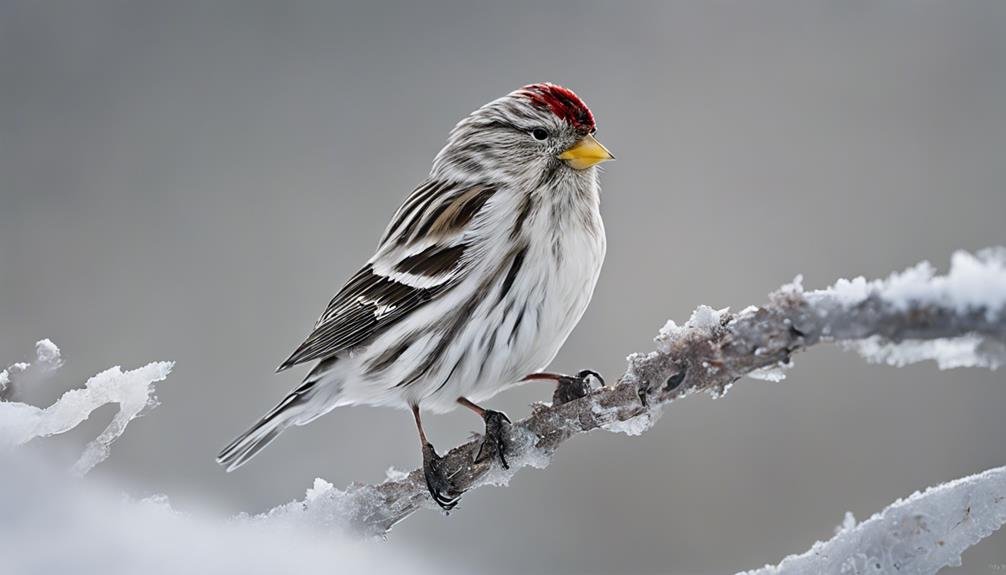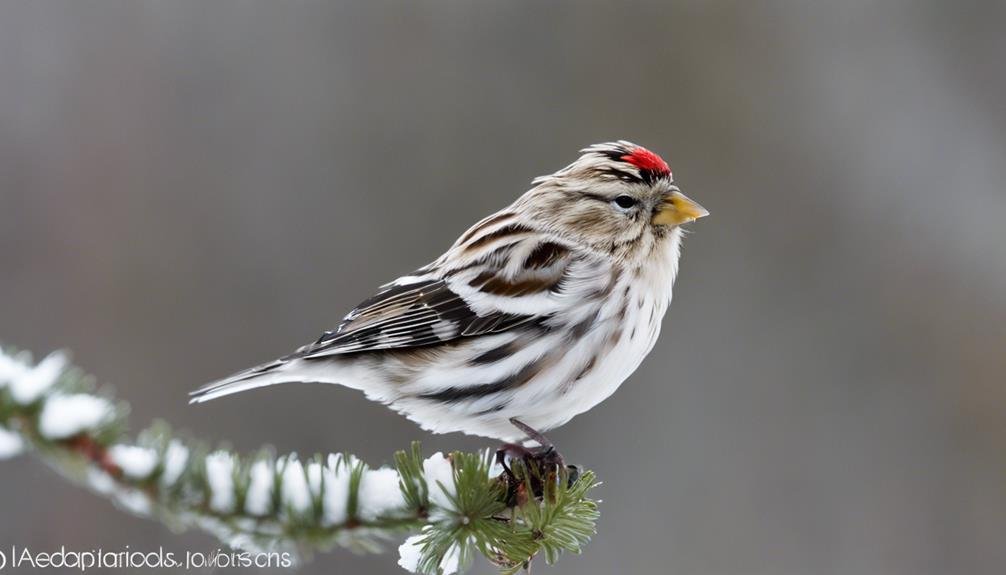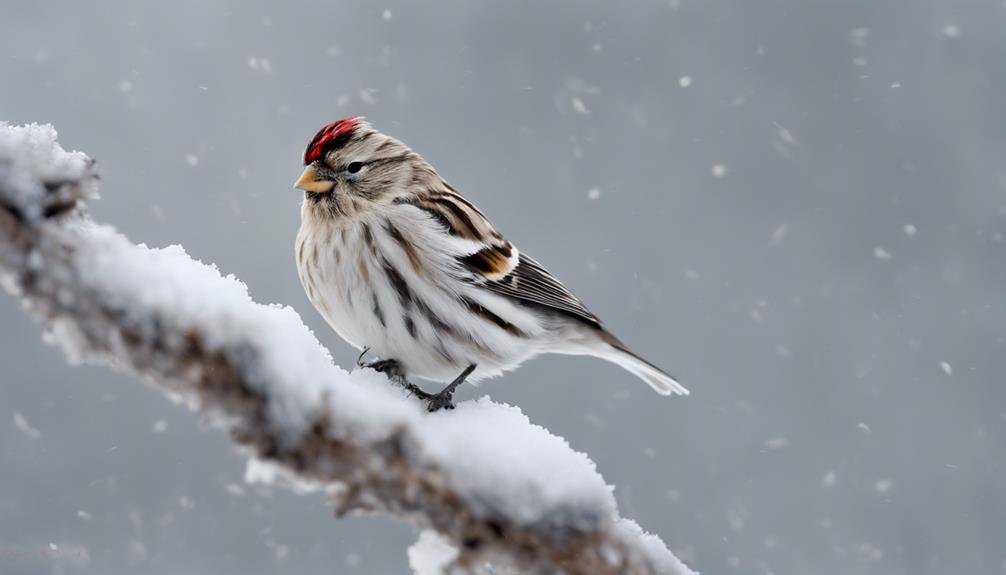Is the Hoary Redpoll merely a lighter version of its cousin, the Common Redpoll? This question often arises among bird enthusiasts and ornithologists alike. In fact, a deeper look into the Hoary Redpoll reveals it as a distinct species with unique adaptations and behaviors.
The Hoary Redpoll is a fascinating bird, specially equipped to thrive in the harsh conditions of its arctic and subarctic habitats. This small finch has adapted to extreme cold with specialized body feathers that provide additional insulation. Its diet predominantly consists of seeds, leading to a foraging behavior that is both efficient and crucial for conserving energy in its frigid environment. Furthermore, the Hoary Redpoll displays irregular migration patterns, sparking discussions on the potential impacts of climate change on its distribution and survival.
This brief overview introduces the Hoary Redpoll as more than just a pale counterpart to the Common Redpoll. It is a species that showcases remarkable resilience and adaptability, offering insights into the broader themes of avian adaptation strategies in the face of changing global climates.
Key Takeaways
Understanding the Hoary Redpoll involves appreciating its impressive ability to live in extremely cold environments. This bird species is well-adapted to survive in the High Arctic, showcasing unique dietary habits and behaviors suited to this harsh habitat.
The impact of climate change poses a significant threat to the Hoary Redpoll, highlighting the urgency for targeted conservation efforts to ensure its survival. The phenomenon of irruption, along with its subtle differences from the Common Redpoll, offers valuable insights into bird ecology and the adaptability of species.
Key Takeaways:
- The Hoary Redpoll exhibits remarkable adaptations to survive in the High Arctic, a testament to its resilience.
- Climate change is a major threat to its existence, emphasizing the need for conservation actions.
- Studying its irruption patterns and differences from the Common Redpoll sheds light on avian ecological dynamics and adaptation strategies.
Scientific Classification
Evolutionary Adaptations of the Hoary Redpoll
The Hoary Redpoll, a distinguished member of the Fringillidae family within the Passeriformes order, demonstrates remarkable evolutionary adaptations. One of the most notable is its complex song capabilities and enhanced learning abilities. This bird, having a brain size larger in proportion to its body, finds itself comfortably placed within the Oscines suborder. This group is celebrated for its members’ ability to produce intricate vocalizations – a hallmark of true songbirds.
Navigating the Arctic Tundra
The Arctic Tundra presents a host of challenges to its inhabitants, but the Hoary Redpoll thrives in this environment through its unique set of adaptations. This bird species is adept at navigating the sparse and silent expanses of the High Arctic, using its elaborate song as a tool for communication and to attract mates. The song of the Hoary Redpoll is an elaborate composition of chirps and trills, crucial for establishing territory in the vast landscapes it calls home.
Distinct Features and Evolutionary Success
While closely related to the Common Redpoll, the Hoary Redpoll boasts distinct features that set it apart. Its place within the Fringillidae family emphasizes its prowess in vocal communication, an evolutionary advantage that has ensured its success in the demanding environments of the arctic tundra. The bird’s elaborate song and its ability to adapt to the extreme conditions of its habitat underscore the evolutionary success of the Hoary Redpoll.
Habitat
Habitat Selection in Harsh Climates
Hoary Redpolls have a remarkable ability to find refuge during the severe High Arctic summer conditions. Their resilience shines in the brushy tundra habitats of the High Arctic, which is pivotal for their survival and significantly influences their life cycle.
Tundra: The Arctic’s Vast Open Landscapes
The expansive and open landscapes of the Arctic tundra stand out as an ideal habitat for Hoary Redpolls. This environment is perfectly suited to their needs, supporting their nesting and foraging behaviors. The ability to utilize this unique ecosystem is key to their survival strategy.
Irruption: A Behavioral Adaptation
Irruption years mark a fascinating behavior in Hoary Redpolls, where they expand their range southwards. This movement is a testament to their habitat preferences, seeking out similar brushy tundra environments even when migrating far from their traditional High Arctic homes.
Coexistence: Sharing the Tundra
An interesting aspect of their habitat is the coexistence with Common Redpolls. This shared preference for brushy tundra environments highlights the adaptability of Hoary Redpolls and their ability to thrive alongside closely related species.
The habitat preferences of Hoary Redpolls demonstrate a complex relationship between their biological requirements and the challenging Arctic environment. Opting for brushy tundra areas in the High Arctic, along with their adaptability during irruption years, emphasizes the critical role of habitat in their survival strategy.
Diet

Hoary Redpolls’ Diet: A Survival Strategy
Understanding the habitat of Hoary Redpolls illuminates their dietary preferences which lean heavily towards seeds such as nyjer and sunflower, with an occasional supplement of small insects and buds. These birds have honed their feeding habits to thrive in cold environments, relying on high-fat seeds to sustain their energy needs. The choice of nyjer and sunflower seeds is strategic, offering the high caloric intake essential for enduring the winter months.
Adaptations in Feeding Behavior
Hoary Redpolls showcase unique adaptations that cater to their dietary requirements. Their ability to efficiently pick seeds and store them in esophageal pouches for later consumption is particularly noteworthy. This strategy not only enables them to stockpile food but also provides a constant energy source during times when food is scarce, showcasing their remarkable adaptation to their environment.
Winter Feeding Habits
Despite their diet being quite similar to that of Common Redpolls, Hoary Redpolls are seldom seen at bird feeders, mainly during the winter. Their occasional presence is a testament to their opportunistic nature, allowing them to tap into alternative food sources when their usual diet is hard to come by. This behavior underscores their ability to adapt to their surroundings and make the most of the resources available to them.
Behaviour

Adaptable Migration Patterns
The Hoary Redpolls display a remarkable capacity for adjusting their migratory behaviors in response to the changing conditions of their Arctic and tundra environments. Their movement isn’t set on a predictable path but varies, highlighting their flexibility and survival tactics in facing the unpredictable nature of their habitats. This adaptability in migration ensures they find the resources needed to thrive throughout the year.
Physiological Adjustments for Temperature Regulation
One fascinating aspect of Hoary Redpoll behavior is their method of dealing with temperature fluctuations. They engage in feather plucking during unusually warm spells, a direct physiological response to maintain an optimal body temperature. This action underscores their intricate connection with the environment, showcasing an innate ability to adjust to sudden changes in their surroundings for survival.
Human Interaction and Dietary Preferences
Hoary Redpolls exhibit a unique level of ease around humans, a trait not commonly observed in many wild bird species. Their occasional visits to bird feeders, where they show a preference for nyjer or sunflower seeds, reveal their dietary adaptability. This interaction not only highlights their comfort in human-proximate environments but also their versatile feeding habits that contribute to their survival in varied conditions.
Through these behaviors, Hoary Redpolls demonstrate a profound bond with their environment, employing a range of strategies that ensure their resilience and survival. From their flexible migration to their innovative ways of temperature regulation and interaction with humans, they embody adaptation and survival in the face of environmental challenges.
Conservation

Resilience of Hoary Redpolls in Changing Climates
The remarkable ability of Hoary Redpolls to adjust to changing environmental conditions demonstrates their resilience. However, the increasing threats to their habitats emphasize the need for immediate conservation actions.
The loss of habitat, especially in the High Arctic tundra where they breed, presents a significant challenge. This issue is intensified by climate change, affecting the availability of suitable habitats for these birds. Protecting critical nesting areas is a priority in conservation efforts to lessen these impacts.
Understanding Migration and Population for Effective Conservation
Studying the migration patterns and monitoring the populations of Hoary Redpolls are vital for conservation plans. These measures allow conservationists and scientists to observe changes in population size and distribution. This information is crucial for making informed management decisions.
Engaging in collaborative efforts that involve governments, environmental organizations, and local communities is vital. These partnerships help in pooling resources and knowledge, thus improving the ability to implement conservation measures successfully.
Climate Change Impacts

Climate change poses a significant threat to the survival of Hoary Redpolls by altering the ecosystems they rely on for breeding and feeding. As the planet warms, these birds, closely related to Common Redpolls, face significant challenges that impact their ability to thrive in their native High Arctic tundra habitats. The intricate balance of their ecosystem is disrupted, leading to a cascade of effects that undermine the survival of Hoary Redpolls.
Impact on Breeding Grounds and Food Sources
One of the immediate threats climate change brings to Hoary Redpolls is the loss of their natural habitat. The warming climate causes a shift in the Arctic’s ecological boundaries, resulting in fewer areas where these birds can nest and feed. This habitat loss isn’t an isolated event but a direct consequence of climate change, affecting not only Hoary Redpolls but also the broader ecosystem they’re a part of.
Moreover, the availability of food is crucial for the survival and reproductive success of Hoary Redpolls. Climate change has the potential to disrupt the timing and availability of these critical food sources. A mismatch between the breeding period of Hoary Redpolls and the peak availability of their food can lead to decreased reproductive success and lower survival rates among these birds.
Changes in Migration and the Need for Conservation Efforts
The alteration of migration patterns is another aspect that requires close monitoring to understand the full impact of climate change on Hoary Redpolls. These changes could affect the birds’ ability to return to their breeding grounds or find sufficient food along their migratory routes.
The importance of collaborative conservation efforts can’t be overstated in mitigating these effects and ensuring the long-term viability of Hoary Redpolls. Through detailed analysis and targeted conservation strategies, there’s hope for mitigating the adverse effects of climate change on Hoary Redpolls and preserving their Arctic ecosystems.
The conversation about climate change and its impact on Hoary Redpolls highlights the need for immediate action to protect these and other vulnerable species from the ongoing effects of a warming planet.
Other Interesting Facts

Exploring the Unique World of Hoary Redpolls
The Hoary Redpolls stand out in the avian community, not just for their resilience in the face of climate change, but also for their captivating features and lifestyle. Let’s dive into the intriguing aspects of these birds that make them a subject of interest.
Distinctive Physical Traits
What sets the Hoary Redpolls apart is their remarkable appearance. They don as if cloaked in winter’s essence, with their pale, frosty plumage that seamlessly blends into their icy habitats. Crowning their heads is a vibrant red patch, a splash of color against the white expanse. The adult males take this visual appeal a notch higher with a subtle pink wash gracing their chests, a characteristic that adds to their allure.
Acrobatic Seed Eaters
Observing Hoary Redpolls in action offers a glimpse into their world of skillful survival. Their seed-eating behavior is nothing short of acrobatic. With finesse, they maneuver and extract seeds, showcasing their adaptability and dexterity. This ability not only highlights their dietary preferences but also reflects their agile interaction with the environment.
Socializing in the Cold
Despite the chilly surroundings, Hoary Redpolls thrive in the company of their own kind and others. Outside the breeding season, they come together to form large flocks, creating a sense of community in the vast, cold landscapes. These gatherings often include their close kin, the Common Redpolls, illustrating the social fabric that binds these species in the face of harsh elements.
Stable Conservation Status
Amid concerns over the welfare of various species due to environmental changes, Hoary Redpolls present a glimmer of hope. With an estimated robust population of about 28 million, their conservation status is classified as of Low Concern. This not only speaks to their resilience but also to the success of conservation efforts aimed at preserving their numbers.
In wrapping up, the Hoary Redpolls are a testament to nature’s marvels. Their unique physical characteristics, acrobatic feeding habits, social behavior, and stable conservation status underscore their remarkable adaptation to their environments. They embody the resilience required to thrive in the face of nature’s adversities, making them a fascinating subject of study and admiration in the avian world.
What is the difference between a Hoary Redpoll and a King Eider?
The Hoary Redpoll and King Eider are two distinct bird species. The Hoary Redpoll is a small, sparrow-sized bird with pale plumage, while the King Eider is a larger duck with striking black and white markings. Interestingly, the King Eider is known for its unique courtship display and distinctive vocalizations.
Frequently Asked Questions
What Are Some Interesting Facts About the Hoary Redpoll?
What habitats do Hoary Redpolls prefer?
Hoary Redpolls are found in cold Arctic habitats, showcasing an incredible tolerance to low temperatures. They adapt well to these harsh environments, making them fascinating subjects of study for ornithologists and bird watchers alike.
What is the population status of the Hoary Redpoll?
The population of the Hoary Redpoll remains stable. This stability indicates that they are effectively managing to survive and thrive in their natural Arctic environments despite potential challenges they may face.
How do Hoary Redpolls exhibit social behavior?
Hoary Redpolls often display unique social behavior by mingling with Common Redpolls. This interaction between different species highlights their social nature and ability to coexist with closely related species during feeding and migration.
What are some unique characteristics of the Hoary Redpoll?
The Hoary Redpoll exhibits remarkable feather variations, which help them to stay insulated against the frigid temperatures of their habitats. Additionally, they have unique breeding habits, further showcasing the adaptability of these birds to their cold environments.
What Do Hoary Redpolls Eat?
What do Hoary Redpolls eat?
Hoary Redpolls primarily consume seeds. They have a preference for nyjer and sunflower seeds. During winter, they forage in flocks in search of food.
How Far Do Redpolls Migrate?
Q: How far do redpolls migrate?
A: Redpolls exhibit variable migration distances. Studies show they can migrate significant distances, influenced by climate conditions. They utilize advanced navigation to migrate successfully from their breeding grounds.
What Do Red Poll Birds Eat?
What do Redpoll birds eat?
Redpoll birds have a varied diet that includes nyjer and sunflower seeds at feeding stations. During the winter months, they primarily consume small seeds. In the summer, their diet shifts to include more insects, providing essential nutrition.
What Are the Key Differences Between the Behavior of Red Phalaropes and Hoary Redpolls?
Red Phalaropes and Hoary Redpolls exhibit distinct behaviors. Red Phalaropes are known for their unique roles, with females being more colorful and leaving males to incubate eggs. Hoary Redpolls are small, social seed-eaters. For more red phalarope information, one can explore their migratory habits and feeding strategies in aquatic environments.
Conclusion
To encapsulate the essence and significance of the Hoary Redpoll, it’s paramount to recognize its extraordinary adaptation to frigid climates, underscoring its resilience. Classified distinctly among birds, it thrives primarily in the High Arctic, attuned in diet and behavior to its challenging environment.
However, the specter of climate change looms large, threatening its existence and underscoring the need for dedicated conservation efforts. The phenomena of irruption and its subtle distinction from the Common Redpoll present intriguing facets for further study, illuminating the intricate dynamics of avian ecology and adaptation.


